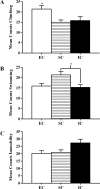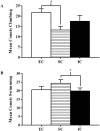Differential Rearing Alters Forced Swim Test Behavior, Fluoxetine Efficacy, and Post-Test Weight Gain in Male Rats
- PMID: 26154768
- PMCID: PMC4496081
- DOI: 10.1371/journal.pone.0131709
Differential Rearing Alters Forced Swim Test Behavior, Fluoxetine Efficacy, and Post-Test Weight Gain in Male Rats
Abstract
Environmental factors play a key role in the etiology of depression. The rodent forced swim test (FST) is commonly used as a preclinical model of depression, with increases in escape-directed behavior reflecting antidepressant effects, and increases in immobility reflecting behavioral despair. Environmental enrichment leads to serotonergic alterations in rats, but it is unknown whether these alterations may influence the efficacy of common antidepressants. Male Sprague-Dawley rats were reared in enriched (EC), standard (SC), or isolated (IC) conditions. Following the rearing period, fluoxetine (10 or 20 mg/kg, i.p.) was administered 23.5 hrs, 5 hrs, and 1 hr before locomotor and FST measures. Following locomotor testing and FST exposure, rats were weighed to assess fluoxetine-, FST-, and environmental condition-induced moderations in weight gain. Results revealed an antidepressant effect of environmental enrichment and a depressant effect of isolation. Regardless of significant fluoxetine effects on locomotor activity, fluoxetine generally decreased swimming and increased immobility in all three environmental conditions, with IC-fluoxetine (10 mg/kg) rats and EC-fluoxetine (20 mg/kg) rats swimming less than vehicle counterparts. Subchronic 20 mg/kg fluoxetine also induced significant weight loss, and differential rearing appeared to moderate weight gain following FST stress. These results suggest that differential rearing has the ability to alter FST behaviors, fluoxetine efficacy, and post-stressor well-being. Moreover, 20 mg/kg fluoxetine, administered subchronically, may lead to atypical effects of those commonly observed in the FST, highlighting the importance and impact of both environmental condition and dosing regimen in common animal models of depression.
Conflict of interest statement
Figures









References
-
- Licinio J, Wong ML. Depression, antidepressants and suicidality: a critical appraisal. Nature Reviews Drug Discovery. 2005; 4: 165–171. - PubMed
-
- Murray CJ, Lopez AD. Alternative projections of mortality and disability by cause 1990–2020: Global Burden of Disease Study. The Lancet. 1997; 349: 1498–1504. - PubMed
-
- Wong DT, Horng JS, Bymaster FP, Hauser KL, Molloy BB. A selective inhibitor of serotonin uptake: Lilly 110140, 3-(p-Trifluoromethylphenoxy)-n-methyl-3-phenylpropylamine. Life Sciences. 1974; 15, (3): 471–479. - PubMed
-
- Cryan JF, Valentino RJ, Lucki I. Assessing substrates underlying the behavioral effects of antidepressants using the modified rat forced swimming test. Neuroscience and Biobehavioral Reviews. 2005; 29: 547–569. - PubMed
Publication types
MeSH terms
Substances
Associated data
LinkOut - more resources
Full Text Sources
Other Literature Sources
Miscellaneous

